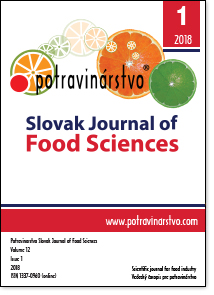Mineral composition of amaranth (Amaranthus L.) seeds of vegetable and grain usage by ARHIVBSP selection
DOI:
https://doi.org/10.5219/863Keywords:
аmaranth, seeds, analytical scanning electron microscopy, Energy Dispersive X-ray Analysis (EDS), ash elementsAbstract
The questions of the practical usage of the analytical scanning electron microscope JSM 600 LA by JEOL company (Japan) with EDS system - microanalysis for the studying of the ash elemental composition of seeds 9 breeds (Vegetable and Grain application) 4 species genus Amaranthus L. - A. hypochondriacus, A. cruentus, A. hybridus, A. caudatus, A. tricolor. Plant seeds by Federal center of vegetable production selection were envisaged. We studied the concentration of 14 basic elements (in weight %) contained in the mineral part of amaranth seeds. In the amaranth seeds of vegetable forms the accumulation order of the elements is the following: Ca >K >P >Mg >Si >Se >Fe >Mo ≈ S ≈ Cl ≈ Zn >Na >Al. In the seeds of the grain forms the order is different: К >P >Ca >Si >Se >Mg >Fe >Na >Mo >Cl ≈ S ≈ Mn ≈ Zn ≈ Al. The amaranth seeds of the grain forms are rich in macro - and microelements. P, K, Cl and S in the seeds of the grain forms are accumulated on 50, 37, 15 and 5% more and Si, Fe and Al in 2.6 and 1.8 times more than in the vegetable forms seeds. The breeds with the high concentration of the elements are recommended for using in the selection process. The elevated level of the essential macro- and microelements such as Ca, K, P, Mg, Mo, S and Cl stipulates the perspective of the functional products creation on the base of the studied amaranth seeds for the enrichment of the food stuffs.
Downloads
Metrics
References
Avtsyn, A. P. Zhavoronkov, A. A., Rishe, A. A. Strochkova, L. S. 1991. Microelementos of man: etiology. classification. Organopathology. Moscow, Russia : Medicine. 496 p. ISBN 5-225-02128-X.
Bojňanská, T., Šmitalová, J. 2015. The influence of additional flours on the retention ability of dough and the technological quality of bakery products. Potravinarstvo, vol. 9, no. 1, p. 242-246. https://doi.org/10.5219/468 DOI: https://doi.org/10.5219/468
Gins, М. S., Gins, V. K. 2011. Physiological and biochemical basis of introduction and selection of vegetable cultures. Мoscow, Russia : PFUR. 190 p. ISBN 978-5-209-03960-0.
Gusev, N. B. 1998. Intracellular Ca-connecting proteins. - Part 1. Classification and structure. - Part 2. Structure and mechanism of functioning Sorovskiy educational journal, vol. 5, p. 2-16.
Gumul, D., Berski, W., Ivanišová, E., Gambuš, H., Kačániová, M., Harangózo, L., Tokár, M. 2017. Characteristics of starch breads enriched with red potatoes. Potravinarstvo Slovak Journal of Food Sciences, vol. 11, no. 1, p. 162-166. https://doi.org/10.5219/720 DOI: https://doi.org/10.5219/720
Jamriška, P. 1996. Analysis of effect of selected factors on amaranth seeds yield. Agriculture (Poľnohospodárstvo), vol. 42, no. 5, p. 352-363.
Peter, K., Gandhi, P. 2017. Rediscovering the therapeutic potential of amaranthus species: A review. Egyptian Journal of Basic and applied Sciences. vol. 4, no. 3, p. 196-205. https://doi.org/10.1016/j.ejbas.2017.05.001 DOI: https://doi.org/10.1016/j.ejbas.2017.05.001
Kamysheva, I. М. 2010. The usage of amaranth seeds derivate products Storage and derivation process of agricultural raw materials, vol. 12, p.67-71.
Kolesnikov, M. P., Gins, V. K. 2001. Forms of silicon in medicinal plants. Applied Biochemistry and Microbiology Journal, vol. 37, no 5, p. 524-527. https://doi.org/10.1023/A:1010262527643 DOI: https://doi.org/10.1023/A:1010262527643
Meathnis, F. G. M. Ichida, A. M., Sanders, D., Schroeder, J. I. 1997. Roles of higher plant K+ channels. Plant Physiology, vol. 114, no. 4, p. 1141-1149. https://doi.org/10.1104/pp.114.4.1141 DOI: https://doi.org/10.1104/pp.114.4.1141
Motyleva, S. M., Kulikov, I. M., Marchenko, L. A. 2017. EDS analysis for fruit Prunus elemental composition determination. Material Science Forum, vol. 888, p. 314-318. https://doi.org/10.4028/www.scientific.net/MSF.888.314 DOI: https://doi.org/10.4028/www.scientific.net/MSF.888.314
Nechaev, А. P., Trauberg, S. Е., Kochetkova, А. А. 2007. Food chemistry. 4th ed. Russia : Gyord Publishing House. 640 p. ISBN: 5-98879-011-9.
Pedersen, B., Kalinowski, L. S, Eggum, B. O. 1987. The nutritive value of amaranth grain (Amaranthus caudatus L.) Protein and minerals of raw and processed grain. Plant Foods for Human Nutrition, vol. 36, no. 4, р. 309-324. DOI: https://doi.org/10.1007/BF01892352
Rastogi, A., Shukla, S. 2013. Amaranthus: A new millennium crop of nutraceutical values. Critical reviews in food science and nutrition. Critical Reviews in Food Science and Nutrition, vol. 53, no. 2, p. 109-125. https://doi.org/10.1080/10408398.2010.517876 DOI: https://doi.org/10.1080/10408398.2010.517876
Schachtman, D. P., Reid, R. J., Ayling, S. M. 1998. Phosphorus uptake by plants: from soil to cell. Plant Physiology, vol. 116, no. 2, p. 447-453. https://doi.org/10.1104/pp.116.2.447 DOI: https://doi.org/10.1104/pp.116.2.447
Shmalko, N. А., Roslyakov, Yu. F. 2011. Amaranth in food industry. Krasnodar, Russia : Prosveshchenie-South. 489 p. ISBN: 978-5-93491-395-4.
Tharun, Rao, K. N., Padhy, S. K., Dinakaran, S. K., Banji, D., Avasarala, H., Ghosh, S., Prasad, M. S. 2012. Pharmacognostic, Phytochemical, Antimicrobial and Antioxidant Activity Evaluation of Amaranthus tricolor Linn. Leaf. Asian Journal of Chemistry, vol. 24, no. 1, p. 455-460.
Vikhreva, V. А., Khryanin, V. N., Gins, V. K. Blinokhvatov, А. F. 2001. Adaptogenic role of Se in higher plants. Reporter of Bashkirskiy University, vol. 2, p. 65-66.
Zheleznov, A. V., Solonenko, L. P., Zheleznova, N. B. 1997. Seed protein of the wild and the cultivated Amaranthus species. Euphytica, vol. 97, no. 2, p. 177-182. https://doi.org/10.1023/A:1003073804203 DOI: https://doi.org/10.1023/A:1003073804203
Downloads
Published
How to Cite
Issue
Section
License
This license permits non-commercial re-use, distribution, and reproduction in any medium, provided the original work is properly cited, and is not altered, transformed, or built upon in any way.






























